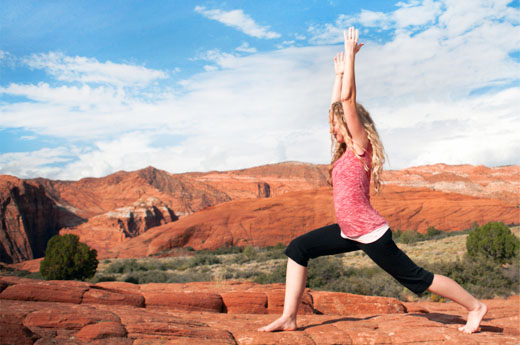
by guest bloggers Jeff Perlman and Holly Walck
Part I of our Ayurveda & Yoga Series
The three doshas (vata, pitta, and kapha) are combinations of the five great elements in our universe. The elements are further understood by the qualities of nature that surround us, such as hot and cold, wet and dry, heavy and light, and mobile and stable. These extremes are reflected in the doshas and help us understand our physical, mental, emotional, and spiritual nature.
The natural balance of one’s doshas is established at conception and is known as prakriti. Our unique balance can become disrupted by factors such as seasonal changes, our physical environments, the foods we eat, and the level of stress in our lives.
The kapha dosha is a combination of the earth and water elements and has the qualities of being cold, wet, heavy, and stable. The grounding qualities of kapha are responsible for the structure of the body, lubrication of the joints and skin, and tissue building that provides stability, stamina, and strength.
When kapha dosha is in balance, these people are unconditionally loving, calm, devoted, consistent, tolerant, dependable, and patient. However, when it’s out of balance, they are physically prone to upper respiratory illnesses, obesity, diabetes, and high cholesterol; mentally and emotionally, they are prone to procrastination, lethargy, inflexibility, stubbornness, depression, and over-attachment.
The base qualities of cold, wet, heavy, and stable start to increase during the cool and damp fall months and then escalate, coming to a peak during the colder, stagnant, and wet winter months. Kapha finally alleviates during the dryer and warmer spring and summer months.
Ayurveda treats imbalance with opposites, so when treating a kapha imbalance, we incorporate warmth, dryness, lightness, and mobility. A lighter diet is suggested using warmer spices like cloves, cinnamon, and ginger with very little dairy, nuts, or added fats. Sweeteners are not especially recommended for kapha, but if one is to be used, honey is the choice because it is heating.
Wearing and being surrounded by warming colors like red, orange, and yellow are invigorating, and it is important to get out in the sunlight and have a regular exercise program that boosts metabolism.
The yoga practice for the kapha dosha should be energetic, stimulating, challenging, and warming. The poses should be repeated and held longer with conscious breathing. All standing poses, inversions, and especially backbends are essential, and your Deep Relaxation Pose (Savasana) should be shortened.
If you have a regular pranayama practice you should be doing Shining Breath (Kapalabhati), seated Ujjayi (sometimes called Ocean Breath), and Solar Nostril Breathing, all of which are cleansing, energizing, and warming.
Salutations to the Sun (Surya Namaskarasana)
Warrior I Pose (Virabhadrasana I)
Revolved Triangle Pose (Parivrtta Trikonasana)
Head Balance Pose (Sirsasana)
*Note: if you have not already been taught Head Balance Pose by a certified yoga teacher, do Downward-Facing Dog (Adho Mukha Svanasana) instead.
Locust Pose (Salabhasana)
Camel Pose (Ustrasana)
Intense Stretch of the Front of the Body Pose (Purvottanasana)
Shoulder Balance Pose (Sarvangasana)
*Note: if you have not already been taught Shoulder Balance Pose by a certified yoga teacher, do Four-Footed Pose (Chatush Padasana) instead.
 Holly Walck uses the healing practices of Ayurveda and Iyengar Yoga to secure her to the core of her being. Her Bachelor’s Degree in Nursing, combined with a Certification in Iyengar Yoga, give her Yoga classes a unique flavor and the ability to approach her students from a place of wholeness. www.yogawithholly.com
Holly Walck uses the healing practices of Ayurveda and Iyengar Yoga to secure her to the core of her being. Her Bachelor’s Degree in Nursing, combined with a Certification in Iyengar Yoga, give her Yoga classes a unique flavor and the ability to approach her students from a place of wholeness. www.yogawithholly.com
 Jeff Perlman is a clinical Ayurvedic and panchakarma specialist, with advanced accreditation in pulse diagnosis and marma therapy; a professional member of the National Ayurvedic Medical Association; a certified massage therapist; a certified Iyengar Yoga instructor; and a Cordon Bleu chef. Find him online at threeseasonsayurveda.com.
Jeff Perlman is a clinical Ayurvedic and panchakarma specialist, with advanced accreditation in pulse diagnosis and marma therapy; a professional member of the National Ayurvedic Medical Association; a certified massage therapist; a certified Iyengar Yoga instructor; and a Cordon Bleu chef. Find him online at threeseasonsayurveda.com.




No comments yet.